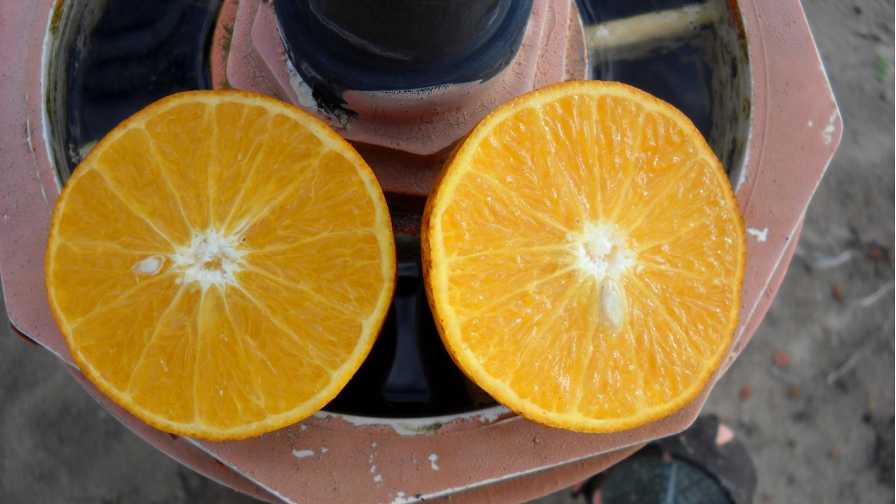
Temple has been used extensively in breeding. Its true identity is generally described as a tangor of unknown parentage.
Photo by Peter Chaires
The Temple tangor has ridden the waves of popularity — and disdain — over the past century. To honor its approximate 100th birthday in Florida, it may be worth revisiting its interesting history and present condition. Based on recent conversations, there are clearly fewer people working in Florida’s citrus industry with any first-hand knowledge of the Temple, its origin, or significance.
There are several variants of the Temple presently or historically grown in Florida: The original or Standard Temple, the ‘Fertic’ (a low-scab selection entered by Dr. Bill Castle), the ‘Sue Linda’, and the ‘Thoro’. Various market names have been assigned over time, and the Temple’s official uses and classification have changed from orange, to a unique citrus category all its own, to present day tangerine/mandarin status. Temple also has been used extensively in breeding.
Its true identity is generally described as a Tangor of unknown parentage. Temples were grown in the Ridge and Indian River regions, though they seem to prefer heavier soils. They favored sour orange and Cleo but were planted on a range of old-line Florida rootstocks.
Temple was discovered in Jamaica in the late 1800s and ultimately found its way to Oviedo and later Winter Park. Once in Winter Park, it came into the hands of W.C. Temple, the former manager of the Florida Citrus Exchange. He introduced the Temple into the marketplace around 1919 to 1920. Though Temple has a unique mandarin/orange flavor, it provided a mid-season variety consumers would perceive to be a peelable orange. Its popularity grew, and Florida peaked at approximately 20,000 acres. Records show harvest seasons of more than six million field boxes.
It was an economically important variety for Florida packinghouses but also was prized in some years by canneries for its good color and brix. Temples had value in blending during the seasonal no-man’s land between the end of the mid-season orange crop and the time when Valencia oranges were of good quality.
One downside of Temple was its high seed count (up to 40 per fruit) but, in its heyday, consumers had not yet developed an infatuation for seedless and low-seeded fruit. Availability of more convenient, later-maturing, easier peeling, seedless navels (mostly from California) quickened its slide into consumer disfavor. Its unique flavor and appearance further exacerbated its struggles at a time when uniform produce was the expectation. Consumers just didn’t know what it was. Unusual and unique were market disadvantages, not strengths.
A Temple with Fewer Seeds
Down the road, Bobby Schlernitzaeur, a Merritt Island grower, discovered a natural, low-seeded Temple mutation and named it after his two daughters, Sue and Linda. The ‘Sue Linda’ Temple had three to nine seeds, considerably less than the standard Temple, but maintained all of its other characteristics. The ‘Sue Linda’ was an immediate hit with the gift fruit industry and ultimately found its way into South African production. Somewhere along the way, likely due to low demand, the ‘Sue Linda’ was dropped from the Bureau of Citrus Budwood Registration Foundation tree program. The last known ‘Sue Linda’ block was on Merritt Island under the care of the late Larry Harvey, but the land was cleared before budwood could be rescued. Florida has since requested budwood from California and it is now undergoing therapy for public domain availability.
The Seedless Temple
The third, and perhaps most intriguing variant is the ‘Thoro’ Temple. Andrew Thoro, who is identified from conversational legend as a hobbyist breeder, planted trees of Temple on rough lemon in his Miami grove in 1939. Three years later, he noticed some seedless fruit. It was not until the fifth year that he discovered the seedless or low-seeded fruit was from one branch of one tree. From this limb, Thoro grafted additional trees through a series of three trials, the third of which was planted in 1973. The fruit remained stable and true to type. Thoro filed for a patent in December 1976, and it was granted in December 1977.
Budwood was entered in the DPI system, but it appears that wood was never ordered or cut. It was not until the Chiefland facility was built and foundation trees were being prepared for relocation, when questions arose about its origin. New Varieties Development & Management Corp. learned the patent had expired. It seems that Thoro had special plans for this variety but passed away before any of them could be realized. The ‘Thoro’ also had made its way into commercial production in South Africa where it was marketed and exported as the ‘Scarlett’. In Florida, the ‘Thoro’ averages zero to four seeds, with the lowest seed counts occurring in isolated or solid plantings.
In Florida and South Africa, Temple trees have typically been planted in the warmer areas. Being from Jamaica, it seems to prefer tropical and subtropical conditions. The trees will survive in cooler areas, but peel coloration and high acidity can degrade the fruit’s marketability. Temple trees have been observed in Sacramento, CA, and South Georgia, but fruit quality information is not available.
Most of the older Temple blocks in Florida have been removed. They suffered from increasingly smaller fruit size, drop, and low overall production. Because these blocks were so old and suffered from a range of maladies and stresses, it is hard to make any concrete determination with regard to HLB. Recent small plantings do appear to be doing well. The trees look healthy and do not seem to be dropping fruit. It may be worthwhile to include one or more of these Temple cultivars in fresh and processing trial programs. Nurseries producing trees for dooryard should certainly consider these options.









